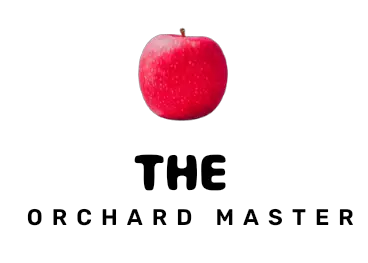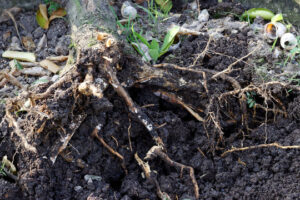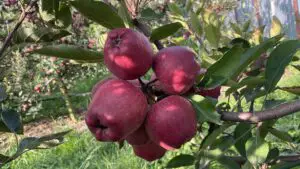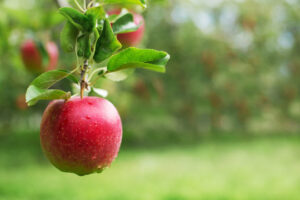Introduction:
Sun-kissed and brimming with nutrients, apples are more than just a popular fruit. They are the product of careful cultivation, the fruition of a tree well looked after and supported. In the world of horticulture, understanding the support systems for apple trees plays a pivotal role in your harvest’s success. For anyone nurturing an orchard or even a single apple tree, this guide explores the range of apple tree support systems and how they optimize apple production.
The most common training systems used for apple and other tree crops include:
- Central Leader System: A single trunk extends vertically from the rootstock with lower scaffold branches radiating out at regular intervals to form the framework. Provides strong central support.
- Modified Central Leader: Similar to the central leader but with two or more competing trunks/branches that share the central leader role. Slightly less rigid structure.
- V-Shaped: Two main branches or trunks radiate upward from the rootstock to form a broad V-shape. Provides a wide base of support.
- Open Center: No central leader, instead has 4-6 main trunks/branches radiating outwards from ground level to form an open center structure.
- Axis System: A strong central trunk has tiers of lateral branches perpendicular to it. Requires staking for support initially.
- Flat Spindle: Low horizontal branches radiate out and are trained along wires for support instead of a central structure.
- Palmette (Fan): Features a central leader with tiers of radiating lateral branches pruned to a fan shape. Requires staking.
- Multi-Trunk/Bush: Several competing trunks form without an explicit central leader. Used for dwarf/semi-dwarf varieties.

Proper training and pruning are needed to maintain these systems which all aim to provide a balanced structural framework through branching patterns and centralized support.
Trellis Systems:
A trellis system forms a pivotal infrastructure that apple tree growers often rely upon. This network of posts and wires provides a sturdy scaffold for apple tree branches, helping guide their growth, simplify management, and ease the harvesting process. Systematically organized and adjustable for different heights, trellis systems can significantly enhance orchard productivity and efficiency.
Tall spindle
- Structural support – The vertically elongated vascular tissue bundles provide a strong central column that helps support the weight of the tree, branches, and fruit. This reduces stress on the tree.
- Water and nutrient transport – The tall spindle configuration efficiently transports water and nutrients from the roots to the leaves and fruit. This nourishes growth and fruit development.
- Branching structure – The tall spindle acts as a central axis that branching stems spread out from in a more open structure. This allows for better airflow, and sunlight penetration, and reduces crowding/shading of interior branches.
- Flowering and fruiting – With good nutrient distribution and less competition/shading, trees with tall spindles tend to flower and fruit more heavily and consistently along the entire branch structure.
- Resistance to weather/disease – The open branching habit made possible by the tall spindle makes the tree more wind resistant. It also allows for better air circulation to reduce humidity and the spread of fungal/bacterial diseases.
- Mechanical support of fruit – As the fruit develops, the tall spindle system and branching structure help bear the weight and prevent limbs from drooping or breaking under a heavy crop load.
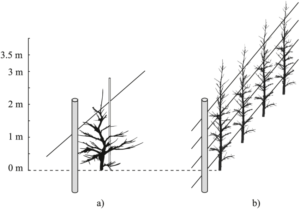
Central leader system
- Central structure – It features a single, straight trunk or leader that extends vertically from the rootstock. This provides a strong central support column for the tree.
- Scaffold branching – Lower branches radiate from the leader trunk at regular intervals. These scaffold branches form the overall tree structure and support secondary branching.
- Open structure – Scaffold branches are spaced out along the leader, creating an open vase-like shape with good light penetration and air circulation throughout.
- Branch control – The leader trunk encourages upward growth while side branches are pruned to remain subordinate. This directs growth energy to the vertical extension of the tree structure.
- Uniform bearing – With scaffold branches arranged along the leader, fruiting wood and crop load is distributed evenly. This prevents overcrowding and stress in any one area.
- Weight distribution – As the tree matures, the leader and scaffold branches help bear and distribute the increasing weight of the crop and branches.
- Accessibility – The open tree structure allows easy access to picking all areas of the tree and for sunlight to ripen fruits throughout.
The central leader system provides a strong yet flexible framework to support an apple tree’s growth, branching, crop load, and long-term structural integrity. Proper pruning maintains this advantageous growth habit.
Espalier Systems:
The ancient horticultural practice of espaliering allows trees to be trained to grow flat, generally against a wall or a specially designed trellis. This approach not only offers structural support to the apple tree but also maximizes the space available. By creating an attractive feature in an orchard or a garden, espalier systems mesh functionality and aesthetics together.
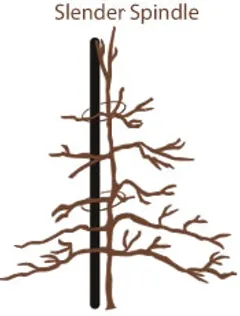
Stake and Guy-Wire Systems:
Beginners growing apple trees or those transplanting young trees, take note of the stake and guy-wire systems. Essential for newly-planted apple trees, stakes provide support to the trunk, while the guy wires provide ancillary stability. This support system encourages straight, upward growth and ensures the tree establishes itself robustly.
V-Shaped Systems:
When strength and stability are your prime requirements, the V-shaped system emerges as the preferred option. Making use of two angled posts for support, this system allows the apple tree’s main trunk to bear its fruit load without worry. The V-shaped system ensures that the apple tree thrives, bringing forth a bountiful harvest.
A V-shaped training system is another common growth habit used for apple trees. Here are some key aspects of how it provides support:
- Central angle – It features two main trunks or branches that radiate upwards from the rootstock at a broad V-shaped angle, usually 60-90 degrees.
- Rigid framework – The wide-angled trunks provide a sturdy, rigid framework that braces against the wind and the weight of the tree structure.
- Open structure – The open V-shape allows good sunlight penetration and airflow throughout the interior of the tree canopy.
- Branch control – Secondary branches are encouraged to grow outward and maintain the open structure rather than inwards.
- Weight distribution – Crop load and leaf/fruit weight are distributed across the two main trunks rather than focused in one area.
- Crotch angles – Proper pruning maintains broad crotch angles where branches meet trunks to prevent weaknesses and breakages.
- Accessibility – The open V-shape allows easy access to pick fruit and perform pruning/pest management throughout the tree.
- Space efficiency – Multiple trees can be planted closer together while still providing adequate support and growth space for each tree.
The V-shape provides a strong yet flexible framework that braces and distributes stresses across the tree for long-term structural integrity.
Open Center Systems:
Also known as the vase system, the open center system involves meticulous pruning of the apple tree to create a bowl-like shape. In facilitating ample sunlight for the inner branches, this system not only offers structural support but also boosts fruit production.
Here are some key aspects of how it provides structural support:
- Central open space – There is no central leader trunk, instead the center of the tree is kept open to allow light penetration deep into the canopy.
- Multi-trunk structure – The tree develops with 4-6 main trunks/branches that radiate outwards from the ground level to form the overall structure.
- Rigid framework – The radiating trunks/branches provide sturdy points of anchorage around the open center to brace against wind and weight.
- Open structure – With the center open, branches are encouraged to grow outward rather than inward, promoting good airflow and reduced disease pressure.
- Uniform bearing – Fruiting wood and crop load are distributed evenly around the outer perimeter of the tree structure rather than focused in one area.
- Weight distribution – As the fruit develops, the branch framework helps distribute crop weight around the tree rather than focusing stresses in the center.
- Accessibility – The open structure allows easy access to pick fruit and perform maintenance throughout the tree.
- Space efficiency – Multiple trees can be planted closer together while still providing adequate support and growth space.
The open center system provides a sturdy yet flexible outer structure to support the tree’s weight and stresses while keeping the interior open.
Conclusion:
Each support system for apple trees offers unique benefits tailored to the specific needs of the tree, available space, and the aesthetic appeal of the orchard or garden. Choosing wisely among trellis, espalier, stake and guy-wire, V-shaped, or open center systems can ensure your venture into apple-growing is prolific and satisfying.
Well-chosen support systems, coupled with diligent care, can help your apple trees flourish, ensuring you enjoy not just the fruit, but also the process of nurturing the tree itself.
